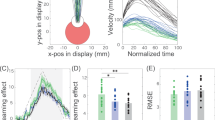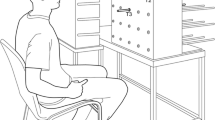Abstract
Sensorimotor adaptation is thought to involve a remapping of the kinematic and kinetic parameters associated with movements performed within a changing environment. Patients with Parkinson’s disease (PD) are known to be affected on this type of learning process, although the specific role of dopamine depletion in these deficits has not yet been elucidated. The present study was an attempt to clarify whether dopamine depletion in PD may directly affect the capacity to internally reorganize the visuomotor remapping of a distorted environment. Fourteen PD patients were tested twice, while they were treated and while they were withdrawn from their regular levodopa treatment. Fourteen control subjects were also enrolled and tested twice. Two parallel forms of the Computed Mirror Pointing Task (CMPT), requiring making a reaching movement in a visually transformed environment (mirror inversion), were administered to each participant. Each of them had to perform 40 trials at each of the 2 testing sessions. At each trial, sensorimotor adaptation was evaluated by the initial direction angle (IDA), which reflects the direction of movement before any visually guided readjustment. Results revealed no IDA difference at baseline, between control subject and PD patients, whether they were treated or not. In all group, IDA values at that time were large, reflecting a tendency to make movements according to the real life visuomotor mapping (based on the natural direct vision). However, striking differences appeared during sensorimotor learning, in that IDA reduction along trials was poorer in patient not treated with levodopa than both control subjects and the same PD patient treated with levodopa. No difference was observed between the treated PD patients and control subjects. Given that IDA is thought to reflect the internal representation of the visuomotor mapping, it is concluded that dopamine depletion in PD would affects sensorimotor adaptation, in that it facilitates old and poorly adapted movements (real life mapping), instead of new and more adapted ones (mirror transformed mapping).






Similar content being viewed by others
References
Asenbaum S, Brucke T, Pirker W, Podreka I, Angelberger P, Wenger S, Wober C, Muller C, Deecke L (1997) Imaging of dopamine transporters with iodine-123-beta-CIT and SPECT in Parkinson’s disease. J Nucl Med 38:1–6
Bedard MA, Scherer H, Delorimier J, Stip E, Lalonde P (1996) Differential effects of D2- and D4-blocking neuroleptics on the procedural learning of schizophrenic patients. Can J Psychiatry 41(7 Suppl 1):S21–S24
Bedard MA, Scherer H, Stip E, Cohen H, Rodriguez JP, Richer F (2000) Procedural learning in schizophrenia: further consideration on the deleterious effect of neuroleptics. Brain Cogn 43(1–3):31–39
Bhushan B, Dwivedi CB, Mishra R, Mandal MK (2000) Performance on a mirror-drawing task by non-right-handers. J Gen Psychol 127(3):271–277
Boulet C, Lemay M, Bedard MA, Chouinard MJ, Chouinard S, Richer F (2005) Early Huntington’s disease affects movements in transformed sensorimotor mappings. Brain Cogn 57(3):236–243
Buch ER, Brasted PJ, Wise SP (2006) Comparison of population activity in the dorsal premotor cortex and putamen during the learning of arbitrary visuomotor mappings. Exp Brain Res 169(1):69–84
Clower DM, Hoffman JM, Votaw JR, Faber TL, Woods RP, Alexander GE (1996) Role of posterior parietal cortex in the recalibration of visually guided reaching. Nature 383(6601):618–621
Cohen MM (1973) Visual feedback, distribution of practice, and intermanual transfer of prism aftereffects. Percept Mot Skills 37(2):599–609
Contreras-Vidal JL, Buch ER (2003) Effects of Parkinson’s disease on visuomotor adaptation. Exp Brain Res 150(1):25–32
Doyon J, Gaudreau D, Laforce R Jr, Castonguay M, Bedard PJ, Bedard F, Bouchard JP (1997) Role of the striatum, cerebellum, and frontal lobes in the learning of a visuomotor sequence. Brain Cogn 34(2):218–245
Doyon J, Laforce R Jr, Bouchard G, Gaudreau D, Roy J, Poirier M, Bedard PJ, Bedard F, Bouchard JP (1998) Role of the striatum, cerebellum and frontal lobes in the automatization of a repeated visuomotor sequence of movements. Neuropsychologia 36(7):625–641
Eslinger PJ, Grattan LM (1994) Frontal lobe and frontal-striatal substrates for different forms of human cognitive flexibility. Neuropsychologia 31(1):17–28
Floyer-Lea A, Matthews PM (2005) Distinguishable brain activation networks for short- and long-term motor skill learning. J Neurophysiol 94:512–518
Folstein MF, Folstein SE, McHugh PR (1975) Mini-mental state. A practical method for grading the cognitive state of patients for clinician. J Psychiatr Res 12(3):189–198
Grafton ST, Maxxiota JC, Prestly S, Friston KJ, Frackowiak RS, Phelps ME (1992) Functionnal anatomy of human procedural learning determined with regional cerebral blood flow and PET. J Neurosci 12:2542–2548
Grosse-Wentrup M, Contreras-Vidal JL (2007) The role of the striatum in adaptation learning: a computational model. Biol Cybern 96(4):377–388
Haaland KY, Harrington DL, O’Brien S, Hermanowicz N (1997) Cognitive-motor learning in Parkinson’s disease. Neuropsychology 11(2):80–86
Harrington DL, Haaland KY, Yeo RA, Marder E (1990) Procedural memory in Parkinson’s disease: impaired motor but not visuoperceptual learning. J Clin Exp Neuropsychol 12(2):323–339
Hoehn MM, Yahr MD (1967) Parkinsonism, onset, progression and mortality. Neurology 17(5):427–442
Inoue K, Kawashima R, Satoh K, Kinomura S, Goto R, Sugiura M, Ito M, Fukuda H (1997) Activity in the parietal area during visuomotor learning with optical rotation. Neuroreport 8(18):3979–3983
Jaeger D, Gilman S, Aldridge JW (1995) Neuronal activity in the striatum and pallidum of primates related to the execution of externally cued reaching movements. Brain Res 694(1–2):111–127
Jeannerod M (1986) Models for the programming of goal-directed movements (or how to get things less complex). Arch Int Physiol Biochem 94(4):C63–C76
Karni A, Meyer G, Rey-Hipolito C, Jezzard P, Adams MM, Turner R, Ungerleider LG (1998) The acquisition of skilled motor performance: fast and slow experience-driven changes in primary motor cortex. Proc Natl Acad Sci USA 95(3):861–868
Kennedy KM, Raz N (2005) Age, sex and regional brain volumes predict perceptual-motor skill acquisition. Cortex 41(4):560–569
Khan MA, Franks IM, Elliott D, Lawrence GP, Chua R, Bernier PM, Hansen S, Weeks DJ (2006) Inferring online and offline processing of visual feedback in target-directed movements from kinematic data. Neurosci Biobehav Rev 30(8):1106–1121
Krakauer JW, Ghilardi MF, Mentis M, Barnes A, Veytsman M, Eidelberg D, Ghez C (2004) Differential cortical and subcortical activations in learning rotations and gains for reaching: a PET study. J Neurophysiol 91(2):924–933
Krebs HI, Hogan N, Hening W, Adamovich SV, Poizner H (2001) Procedural motor learning in Parkinson’s disease. Brain Res 141(4):425–437
Kropotov JD, Etlinger SC (1999) Selection of actions in the basal ganglia-thalamocortical circuits: review and model. Int J Psychophysiol 31(3):197–217
Martin TA, Norris SA, Greger BE, Thach WT (2002) Dynamic coordination of body parts during prism adaptation. J Neurophysiol 88(4):1685–1694
Messier J, Adamovich S, Jack D, Hening W, Sage J, Poizner H (2007) Visuomotor learning in immersive 3D virtual reality in Parkinson’s disease and in aging. Exp Brain Res 179(3):457–474
Mink JW (1996) The basal ganglia: focused selection and inhibition of competing motor programs. Prog Neurobiol 50(4):381–425
Nakajima Y (1988) Effects of up-down visual inversion on motor skills. Percept Mot Skills 67(2):419–422
Paquet F, Soucy JP, Stip E, Levesque M, Elie A, Bedard MA (2004) Comparison between olanzapine and haloperidol on procedural learning and the relationship with striatal D2 receptor occupancy in schizophrenia. J Neuropsychiatry Clin Neurosci 16(1):47–56
Petersen SE, van Mier H, Fiez JA, Raichle ME (1998) The effects of practice on the functional anatomy of task performance. Proc Natl Acad Sci USA 95(3):853–860
Richer F, Chouinard MJ, Rouleau I (1999) Frontal lesions impair the attentional control of movements during motor learning. Neuropsychologia 37(12):1427–1435
Riederer P, Wuketich S (1976) Time course of nigrostriatal degeneration in parkinson’s disease. A detailed study of influential factors in human brain amine analysis. J Neural Transm 38:277–301
Sarazin M, Deweer B, Merkl A, Von Poser N, Pillon B, Dubois B (2002) Procedural learning and striatofrontal dysfunction in Parkinson’s disease. Mov Disord 17(2):265–273
Scherer H, Bedard MA, Stip E, Paquet F, Richer F, Beriault M, Rodriguez JP, Motard JP (2004) Procedural learning in schizophrenia can reflect the pharmacologic properties of the antipsychotic treatments. Cogn Behav Neurol 17(1):32–40
Seidler RD, Noll DC, Chintalapati P (2006) Bilateral basal ganglia activation associated with sensorimotor adaptation. Exp Brain Res 175(3):544–555
Siegert RJ, Taylor KD, Weatherall M, Abernethy DA (2006) Is implicit sequence learning impaired in Parkinson’s disease? A meta-analysis. Neuropsychology 20:490–495
Soliveri P, Brown RG, Jahanshahi M, Caraceni T, Marsden CD (1997) Learning manual pursuit tracking skills in patients with Parkinson’s disease. Brain 120(Pt 8):1325–1337
Teulings HL, Contreras-Vidal JL, Stelmach GE, Adler CH (2002) Adaptation of handwriting size under distorted visual feedback in patients with Parkinson’s disease and elderly and young controls. J Neurol Neurosurg Psychiatry 72(3):315–324
Tracy J, Flanders A, Madi S, Laskas J, Stoddard E, Pyrros A, Natale P, DelVecchio N (2003) Regional brain activation associated with different performance patterns during learning of a complex motor skill. Cereb Cortex 13(9):904–910
Ungerleider LG, Doyon J, Karni A (2002) Imaging brain plasticity during motor skill learning. Neurobiol Learn Mem 78:553–564
Zgaljardic DJ, Borod JC, Foldi JC, Mattis P (2003) A review of the cognitive and behavioral sequelae of Parkinson’s disease: relationship to frontostriatal circuitry. Cognit Behav Neurol 16(4):193–210
Acknowledgments
The authors would like to thank Mr D. Richard, from DOCO Microsystems Inc. for his technical support. This study was supported by the “Fonds de la recherche en santé du Québec” (FRSQ), the Natural and Sciences and Engineering Research Council of Canada (NSERC), and the Canadian Institutes for Health Research (CIHR).
Author information
Authors and Affiliations
Corresponding author
Rights and permissions
About this article
Cite this article
Paquet, F., Bedard, M.A., Levesque, M. et al. Sensorimotor adaptation in Parkinson’s disease: evidence for a dopamine dependent remapping disturbance. Exp Brain Res 185, 227–236 (2008). https://doi.org/10.1007/s00221-007-1147-1
Received:
Accepted:
Published:
Issue Date:
DOI: https://doi.org/10.1007/s00221-007-1147-1




